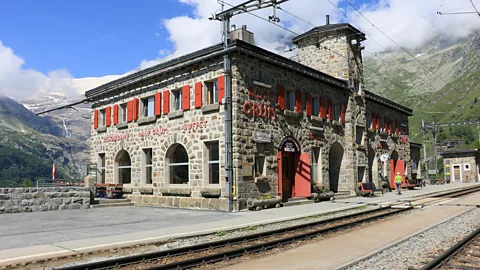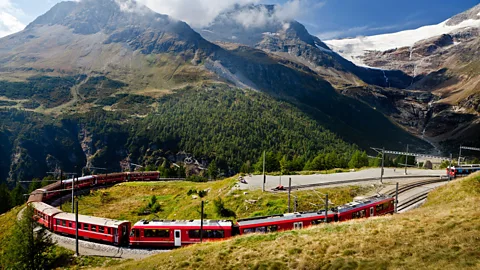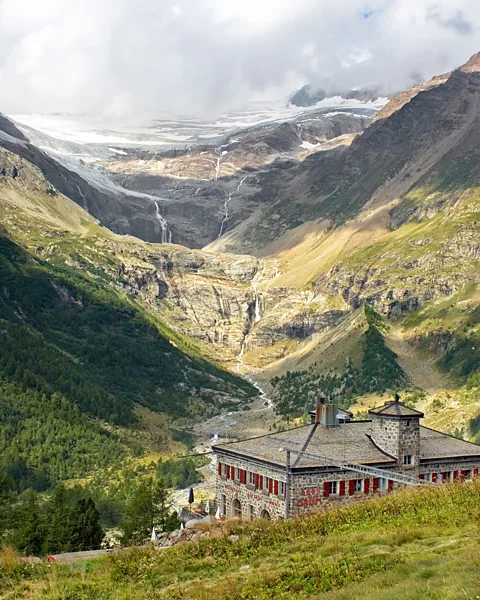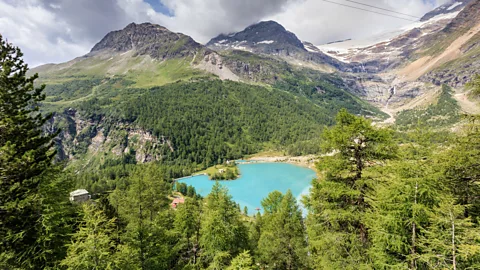The Swiss hotel cut off from the world for 12 hours a day
 Mike MacEacheran
Mike MacEacheranWhile Switzerland is full of Alpine huts and hard-to-reach hotels, Alp Grüm is a mountain anomaly like no other.
"Happily, there are no roads. There is only nature. Sunrises. Sunsets. Stillness. Nothing more, " Primo Semadeni, the 57-year-old manager of Alp Grüm hotel in Graubünden, told me as we stood overlooking a high-altitude pass covered in perpetual snow. The soundtrack was whispering wind, singing birds and rushing water as a river tumbled down the valley.
"Look around, we have mountains and glaciers and are far from everyday life. This is a challenge, but also our blessing."
Hard-to-reach hotels and huts are a Swiss specialty, with many preserved as monuments to Alpine history. The Jungfrau Region, within the snow-ruffled reaches of the Bernese Alps, is for lofty shelters in the car-free villages of Mürren, Wengen and Kleine Scheidegg, where accommodation can only be accessed by ski lift, cable car or cogwheel train. These are places of meditation, where hikers wander and the mind slows.
Then there is an alphabet of striking refuges hidden in mountain eyries, from the Appenzell Alps to Zermatt. Great St Bernard Hospice in Valais is a remarkable example, requiring a continual push by snowshoe in winter, or a high-altitude access road, which only opens to traffic after the thaw.
But Alp Grüm, straddling a razor-edge ridge on the south side of the Bernina Pass at 2,091m, pushes such extremes to the limits. It is caught between languages, with the immediate north speaking Romansh and the valley below Italian. There is no road to it beneath Piz Bernina, the highest peak of the Eastern Alps. And the only way to get there year-round is to hike in for hours – not recommended in winter – or take the Rhaetian Railway that climbs high between the little towns of Pontresina and Poschiavo near the Italian border.
 Alamy
AlamyWhat's more, the hotel's identity is wholly drawn from the history of the rail company, and it doubles as train station, platform and waiting room. Between 20:00 and 08:00, however, the trains leave the rails and the hotel is cut off from the rest of Switzerland, left to exist in a bubble of its own.
Visiting the Alps can so often feel like stepping into a storybook, and that feeling is particularly strong in the Engadin valley, where the horizon is a lithograph of great mountains that crest like waves. I've been to the area many times – to measure my experience of Switzerland at its wildest against that of the pioneers of winter sports tourism – but this time I was in comfort, on board the Bernina Express and travelling south from Chur, the oldest town in Switzerland.
RAIL JOURNEYS
Train Journeys is a BBC Travel series that celebrates the world's most interesting train rides and inspires readers to travel overland.
The story of Alp Grüm started in 1906 with Bernina-Bahngesellschaft, a visionary rail company that unveiled an ambitious plan for an electrified train connecting Switzerland with Italy beneath a roll and tumble of mountains and glaciers. What made the idea so extraordinary was that it would become the Alps' highest rail crossing, prising open the area for tourists but also slashing travel time for traders; back then, it took horse-riding messengers nine hours to complete the dangerous journey between Samedan and Tirano. The struggle was intensified in winter due to avalanche risk and the possibility of becoming stranded by heavy snowfall.
To say Switzerland did not have precedent for this sort of engineering project would be to engage in understatement. Thirty years prior in 1888, Dutch hotelier Willem Jan Holsboer founded the nearby Landquart-Davos narrow-gauge railway. The town of Davos is best known for the World Economic Forum, but its roots are as a spa town, and Holsboer capitalised by way of bringing more visitors to the resort than the horse-drawn carriages did. No less of a marvel before that was the opening of the Gotthard Railway from Immensee to Chiasso in 1882, featuring what was then the world's longest rail tunnel.
 Alamy
AlamyIt was against this background, on a sunny day in July 1910, that the Bernina Line was opened and Alp Grüm began life – not as a stone-built, 10-room hotel and waiting room as it is today, but as a timber cabin, from where the station chief could check the line every morning.
The Rhaetian Railway took control of the Bernina Line in 1943, and the idea, as company spokesperson Camille Härdi describes it, was simply "a rest stop" – a notion that is hard to believe today.
"The Bernina Line wasn't even originally supposed to operate all year round," Härdi said. "However, the railway's management board decided in 1910 – once the line to Tirano had been finished – to acquire a snow plough. It first came into use in the winter of 1910/11 and proved to be a wondrous piece of technology, capable of cutting the considerable costs normally associated with snow-clearing."
These days, the Bernina Line rarely, if ever, closes, meaning Alp Grüm is no longer the Shangri-La it once was. "Winter has changed over the years with the glaciers receding and global warming," said Härdi. "Even so, it still happens there is plenty of snow. There's a locomotive called a 'Snow Blower' that makes sure the train runs even after a heavy snowfall."
Stay at Alp Grüm
Alp Grüm is no ordinary mountain hotel. The reception doubles as a traditional train station cafe-bar, with a counter for speedy coffee and schnapps and tables for hot snacks and Swiss-Italian fare. Through a side-door in the dining room, a staircase leads to the bedrooms, which sit above the train station's waiting room. The 10 ensuite rooms, kitted out with simple wooden furniture and warm fabrics, offer glacier views and supreme silence after nightfall.
To book, contact the hotel directly. Singles/doubles/triples cost CHF 90/160/200 (approx £80/£140/£180) per night, including breakfast.
Imagine the excitement of trainspotters today: the Unesco World Heritage-listed Bernina Line is home to the world's only self-propelled, steam-powered snow plough locomotive.
 Alamy
AlamyBut plenty of the original impulse to build Alp Grüm survives. The geometry of the glaciers and lakes remains impeccably beautiful, and when I arrived, I was immediately transfixed by the Palü Glacier and the blue-green Lago Palü at its terminus.
Above was Ospizio Bernina, the Alps' highest rail crossing at 2,253m. Far below, looking down towards Valposchiavo, the serpentine curve of the tracks switch-backed down a steeply pitched slope. Foregrounding that, the station, remodelled in stone in 1923, was gloriously isolated. It had the air of an Italian villa transferred to a mountaintop, with pizzoccheri (flat short buckwheat noodles) the specialty of its platform restaurant.
More like this:
• Europe's stunning high-tech luxury train
• A new night train connecting some of Europe's great cities
The hardest part about living at Alp Grüm, according to Semadeni, who has spent 18 years here, is the unpredictability each day brings. And to put it mildly, it was one of those days. "This morning, one of my waitresses quit," said Semadeni, sighing. "She jumped on the train and left for anywhere but here. Understand, this is not only a job. It's a lifestyle being up here."
There are also problems with the line's supply chain. Everything served in the restaurant for 10 months a year (the hotel closes in November and for one month after Easter) arrives by train, and the sublime location doesn't always compensate for things not arriving on time. Appropriately, while we chatted, Semadeni was awaiting a delivery of prosciutto crudo.
 Alamy
AlamyThese are mountains that are full of peril – avalanches, landslides, glacial crevasses, thunderstorms and rockfalls. Clearly, running out of Italian ham is one of the more manageable hardships.
"Of course, but I can't go anywhere else to get it," smiled Semadeni, his mood brightening. "And if I forget to order bread, we don't have any either. Some winter days, that's OK as we have no guests. But when the sun shines, 60 or more people can show up."
Semadeni's other complaint – perhaps most annoying of all – is the days when the line is closed, of which he has experienced many. Happily, the service has only been interrupted once this year. No mountain monk, Semadeni likes the rhythm of new arrivals.
Alp Grüm is, without doubt, an unsung Swiss landmark – and there is splendour everywhere. An Alpine garden of lady's mantle, edelweiss, lemon balm and peppermint blooms in summer. In winter, the high ground seems to close in at night, in collusion with the stars. And when the last train leaves for the day, there is an almost unattainable silence.
I was glad I'd visited. It'd been a trip into a part of Switzerland so few see. There is only nature, Semadeni had said. Stillness and nothing more.
It was very easy to see what he meant.
--
This story was first published in October 2024 and was one of our most-read Travel stories of the year.
If you liked this story, sign up for The Essential List newsletter – a handpicked selection of features, videos and can't-miss news, delivered to your inbox twice a week.
